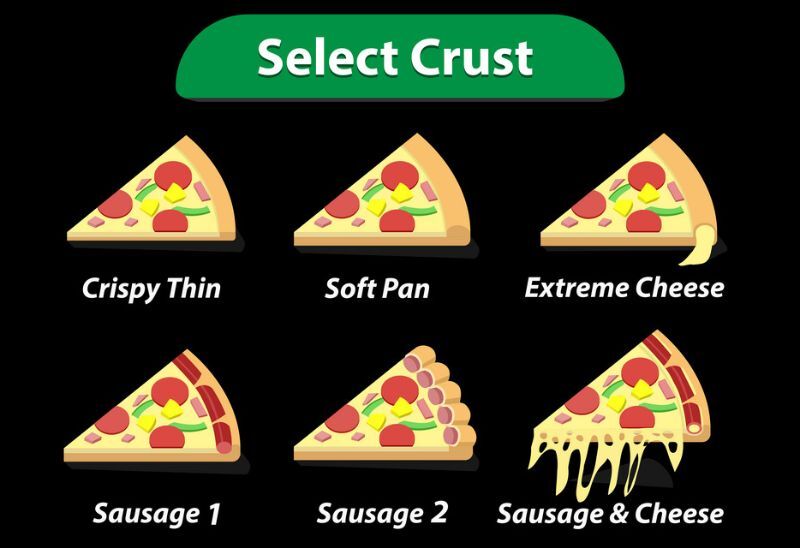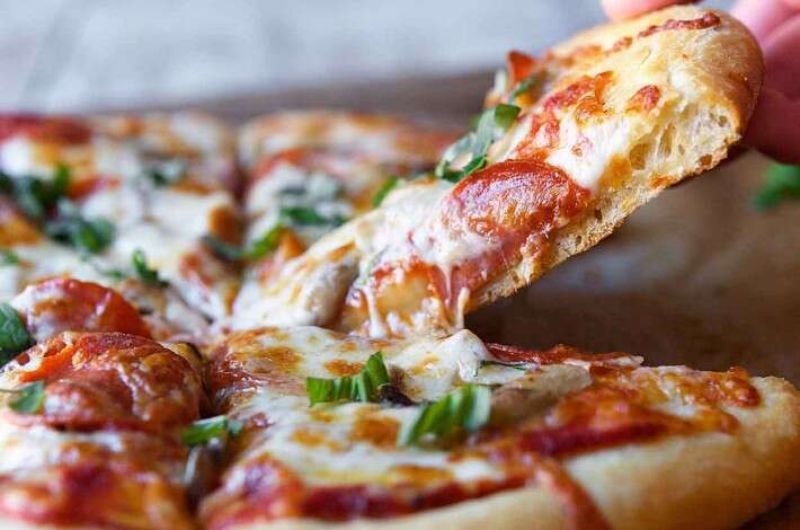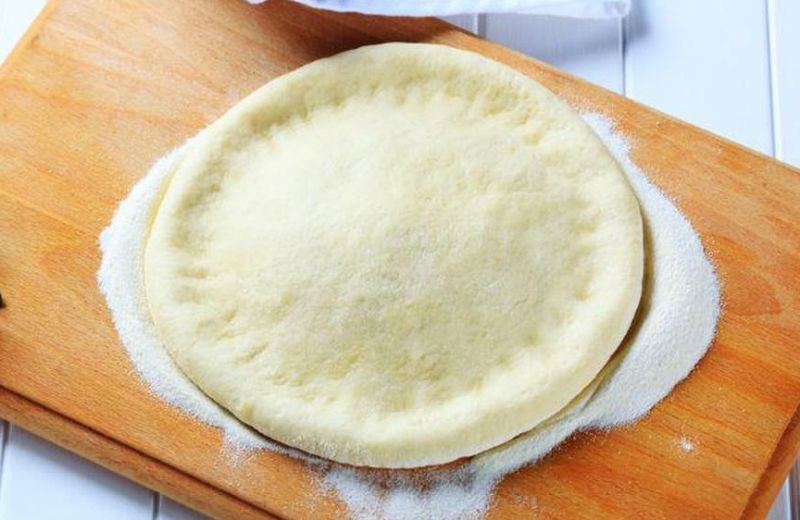If you are like most people, you love pizza. But have you ever stopped to think about all of the different types of pizza crusts?
There are six different types of crusts, each with its own unique flavor and texture. In this blog post, we will take a closer look at each type of crust and find out what makes them so special. So, without further ado, let’s get started!
Table of Contents
List of 6 Pizza Crust Types with Detailed Seasonal Information
- Regular Crust
- Thin Crust
- Thick Crust
- Deep-Dish Crust
- Stuffed Crust
- Hand-Tossed Crust
There are many different types of pizza crusts that you can choose from, depending on your personal preferences. The most common types of pizza crusts are regular, thin, thick, deep-dish, stuffed and hand-tossed.
Regular crust is the most basic type of pizza crust and is usually the cheapest option. Thin crust pizzas have less dough and are often considered to be healthier than regular crust pizzas. Thick crust pizzas have more dough and are often more filling. Deep-dish pizzas have a deep, sturdy pastry base which can be filled with various toppings. Stuffed pizzas have a crust that is stuffed with cheese or other fillings. Hand-tossed pizzas are made by hand and have a more irregular shape.
Which Pizza Crust Types are your favorite?

Regular Crust
Regular Crust pizza is a pizza made with wheat flour, water, salt, and yeast. Once the dough has doubled in size, it is shaped into a round and then left to rest for 10-15 minutes.
Thin Crust
Thin crust pizza dough is made from wheat flour, water, salt, and yeast. Once the dough has doubled in size, it is rolled out thin and then left to rest for 10-15 minutes. The pizza is then topped with your favorite toppings and baked at a high temperature, typically around 500 degrees Fahrenheit.
Deep-Dish Crust
Deep dish pizza dough is made from wheat flour, water, salt, and yeast. The dough is kneaded by hand oren left to rest for 10-15 minutes.
Stuffed Crust
Stuffed crust pizza dough is made from wheat flour, water, salt, and yeast. The dough is kneaded by hand or machine and then left to rise for 30 minutes to an hour. Once the dough has doubled in size, it is shaped into a round and then stuffed with your favorite toppings. The pizza is then baked at a high temperature, typically around 500 degrees Fahrenheit.
Hand-Tossed Crust
Hand-tossed pizza dough is made from wheat flour, water, salt, and yeast. The dough is kneaded by hand and then left to rise for 30 minutes to an hour. Once the dough has doubled in size, it is shaped into a round and th then left to rest for 10-15 minutes.
Regular Crust or Deep Dish? Which Pizza Crust Type is better?
Pizza lovers debate over which is better: regular crust or deep dish? While both have their pros and cons, it ultimately comes down to personal preference. Regular crust pizza is thinner and crunchier, while deep dish pizza is thicker and doughier.
If you’re looking for a classic pizza experience, regular crust is the way to go. But if you want something heartier and more filling, deep dish is the better option. Whichever way you slice it, pizza is always a delicious treat! When it comes to pizza, there are two main types of crusts that people tend to enjoy: regular and deep dish. But which one is the best? It really depends on your personal preferences.
If you’re looking for a pizza with a crispy, thin crust, then regular is the way to go. On the other hand, deep dish pizza has a thick, fluffy crust that’s perfect for those who like their pizza a little doughier.
No matter which type of pizza you prefer, there’s no doubt that it’s one of the most delicious foods out there! So next time you’re feeling hungry, be sure to grab a slice (or two) of your favorite kind.
Pizza peel how to use
A pizza peel is a large, flat tool that is used to slide pizzas in and out of ovens. Peels come in a variety of sizes and materials, including wood, aluminum, and stainless steel. Many peels also have a long handle to allow the user to keep their hands away from the heat of the oven.
To use a pizza peel, first flour or cornmeal is sprinkled onto the peel to prevent the pizza dough from sticking. Then, the pizza dough is placed on the peel and topped with sauce and toppings. The pizza is then slid off of the peel and into the oven.
Once the pizza is cooked, it is slid back onto the peel and transferred to a cutting board or serving platter. pizza peel how to use A pizza peel is a large, flat tool that is used to slide pizzas in and out of ovens.
Why Is The Crust So Important?
The pizza crust is important for a few reasons.
- First, it holds all of the toppings on your pizza.
- Second, it provides a delicious, crunchy texture that complements the softness of the cheese and sauce.
- Third, the crust helps to absorb some of the moisture from the pizza so that the pizza doesn’t become soggy.
- Lastly, the crust adds another layer of flavor to the pizza.
The Most Important Qualities Of The Perfect Pizza Crust
- Crispy
- Chewy
- Slightly charred
- A bit of saltiness
- Light and fluffy
- Not too thick or thin
The perfect pizza crust is crispy, chewy, slightly charred, and has a bit of saltiness. It should be light and fluffy, but not too thick or thin. The pizza dough should be easy to work with and not too sticky.
Tips To Make Your Own Homemade Pizza Crust At Home

When it comes to pizza, there are a lot of different ways that you can make your own crust. You can either buy a pre-made crust or make your own. If you’re looking for a way to save money and make your own crust, then here are some tips to help you out.
One of the first things that you need to do is gather all of the ingredients that you’ll need. This includes things like flour, water, salt, yeast, and olive oil. Once you have all of these things, you can start to mix them together.
When it comes to mixing the ingredients together, you want to make sure that they’re well blended. You don’t want any lumps in your dough. Once the ingredients are well blended, you can start to knead the dough.
Kneading the dough is important because it helps to get the gluten strands in the flour to break down. This will make the dough more elastic and easier to work with. If you don’t knead the dough well, then it will be very difficult to work with and you may end up with a crust that’s too dense.
Once the dough is kneaded, you can start to shape it into a ball. You want to make sure that the ball is about the same size as a tennis ball. Once the dough is shaped into a ball, you can start to flatten it out.
When it comes to flattening the dough, you want to use a rolling pin. You don’t want to use your hands because this can make the dough too sticky. Once the dough is flattened out, you can start to roll it up.
Once the dough is rolled up, you can start to shape it into a crust. You want to make sure that the crust is about the same thickness as the dough that you started with. Once the crust is shaped, you can start to bake it.
When it comes to baking the crust, you want to preheat your oven to about 425 degrees Fahrenheit. Once the oven is preheated, you can put the crust in and let it bake for about 25 minutes.
Once the crust is baked, you can start to add your toppings. You can either use a store-bought pizza sauce or you can make your own. If you’re making your own sauce, you want to make sure that you cook it first so that the flavors can meld together.
Once the sauce is cooked, you can start to add your toppings. You can either use pre-made toppings or you can make your own. If you’re making your own toppings, you want to make sure that they’re cut into small pieces so that they’ll fit on the crust.
After you’ve added your toppings, you can start to bake the pizza. You want to bake the pizza for about 20 minutes or until the cheese is melted and bubbly.
Once the pizza is done, you can let it cool for a few minutes before serving. You can either slice it into pieces or you can serve it whole. If you’re serving it whole, you want to make sure that you slice it into thin strips so that everyone can get a piece.
If you follow these tips, you should be able to make your own pizza crust at home without any problems. Just remember to experiment with different toppings and sauces so that you can find the perfect combination for your family.
FAQS
Is There A “Best” Pizza Crust?
There are so many different Pizza Crust Types out there that it can be hard to decide which one to choose. Some people prefer a thin and crispy crust, while others like a thick and chewy crust. There are also gluten-free and vegan options available for those with dietary restrictions. So, is there a “best” pizza crust?
Well, that’s a tough question to answer. If you like a crispy crust, then you might want to try a thin and crispy crust. If you prefer a thick and chewy crust, then you might want to go with a thicker crust. There are also a variety of gluten-free and vegan crusts available, so you can choose the option that best fits your dietary needs.
Ultimately, it’s up to you to decide what type of pizza crust you prefer. There are many different options out there, so take your time and experiment until you find the perfect one for you. Who knows, you might even discover a new favorite pizza crust!
What to add to pizza crust to make it taste better?
There are a few things that you can add to your pizza dough or crust to make it taste even better.
You could try adding a bit of garlic powder, onion powder, or even some dried herbs like oregano or basil. Another idea is to brush the crust with a bit of olive oil before you bake it, which will give it a nice flavor and make it slightly crispy. Finally, if you want a really cheesy crust, you could try sprinkling some grated Parmesan cheese on top before baking.
Experiment and see what you like best!
What percentage of people prefer thin crust pizza?
It’s hard to say for sure, but it seems like thin crust pizzas are becoming more and more popular. A lot of people seem to like the lighter, crispier texture of a thin crust pizza, and they’re also generally easier to eat. Plus, there are a lot of different ways to make a thin crust pizza, so there’s bound to be one that appeals to everyone.
Is it possible to make a gluten-free pizza dough?

Yes, it is possible to make a gluten-free pizza dough. There are a few different recipes that you can use in order to make a gluten-free pizza dough. One recipe that you can use is the following:
Ingredients:
- 1 cup brown rice flour
- 1/2 cup tapioca flour
- 1/2 cup potato starch
- 1 teaspoon xanthan gum
- 1 teaspoon salt
- 1 tablespoon olive oil
- 1 cup warm water
Instructions:
- Preheat oven to 425 degrees F (220 degrees C). Grease a baking sheet.
- In a large bowl, combine brown rice flour, tapioca flour, potato starch, xanthan gum, and salt. Stir in olive oil and warm water until the dough is smooth.
- Place dough on the prepared baking sheet. Pat into a 12 inch circle.
- Bake for 10 minutes. Remove from oven and add your desired toppings.
- Bake for an additional 10-15 minutes, or until the crust is golden brown.
Why is thin crust better?
There are a few reasons why thin crust is generally considered to be better than thick crust.
First, thin crust pizza cooks more evenly, so you’re less likely to end up with a slice that’s overcooked or burnt. Second, thin crust pizza is typically lighter and easier to eat, since there’s less dough overall. And finally, thin crust pizza tends to have a more intense flavor, since the ratio of sauce to dough is higher.
So if you’re looking for a delicious and satisfying pizza experience, thin crust is usually the way to go.
What’s the difference between thick crust and thin crust pizza toppings?
The two types of pizza crusts have different thicknesses. Thick crust pizza has a thicker dough, while thin crust pizza has a thinner dough. The toppings on each type of pizza also vary. Thick crust pizza typically has more toppings, while thin crust pizza typically has fewer toppings.
When it comes to taste, some people prefer thick crust pizza because it is more filling and has more flavor. Others prefer thin crust pizza because it is lighter and crispier. Ultimately, the choice of crust is a matter of personal preference.
What makes pizza dough different from bread dough?
Pizza dough is made with a high-gluten flour, which gives it a chewy texture. Bread dough is made with a lower-gluten flour, which gives it a fluffy texture. Pizza dough is also allowed to rise for a longer period of time than bread dough, which gives it a more distinct flavor.
Conclusion for Pizza Crust Types
Thanks for reading. We hope you found this post helpful in understanding the different Pizza Crust Types and how they can affect your pizza experience!
